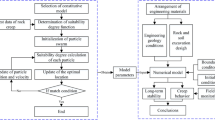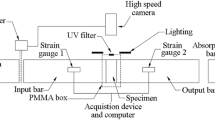Abstract
This paper describes a comprehensive idea for stability evaluation of anhydrite mine-out used as an underground gas storage, including the inversion analysis of contact model parameters of anhydrite rock and numerical analysis based on discrete element method (DEM). Applying the particle swarm optimisation algorithm (PSO), a unified fitness function was defined based on multiple mechanical parameters of the materials, and the contact model parameters of anhydrite rock based on DEM were back analysed with high precision and efficiency. In addition, the similarity theory was introduced to reduce the size of the practical geotechnical structures and improve the computational efficiency of DEM. Taking Anhui Hengtai Anhydrite mine as an engineering case, the stability of the anhydrite mine-out used as an underground gas storage was evaluated and the optimal internal storage pressure was determined, which provides a reference for the reuse of anhydrite mine-out.
















Similar content being viewed by others
References
Annabattula RK, Gan Y, Kamlah M (2012) Mechanics of binary and polydisperse spherical pebble assembly. Fusion Eng Des 87:853–858
Asaf Z, Rubinstein D, Shmulevich I (2007) Determination of discrete element model parameters required for soil tillage. Soil Till Res 92(1–2):227–242
Barrasso D, Ramachandran R (2015) Multi-scale modeling of granulation processes: bi-directional coupling of PBM with DEM via collision frequencies. Chem Eng Res Des 93:304–317
Bonilla-Sierra V, Elmouttie M, Donzé FV, Scholtès L (2017) Composite wedge failure using photogrammetric measurements and DFN-DEM modelling. J Rock Mech Geotech Eng 9:41–53
Cavarretta I, O’Sullivan C, Ibraim E, Lings M, Hamlin S, Wood DM (2012) Characterization of artificial spherical particles for DEM validation studies. Particuology 10:209–220
Chen RP, Tang LJ, Ling DS, Chen YM (2011) Face stability analysis of shallow shield tunnels in dry sandy ground using the discrete element method. Comput Geotech 38(2):187–195
Cho N, Martin CD, Sego DC (2007) A clumped particle model for rock. Int J Rock Mech Min 44(7):997–1010
Coetzee CJ (2017) Review: Calibration of the discrete element method. Powder Technol 310:104–142
Cundall PA (1971) A computer model for simulating progressive, large-scale movements in blocky rock systems. In: Proceedings of the International Symposium on Rock Mechanics. Nancy, France, p 129–136
Ding Z, Zhang L, Chen Y, Hu CQ (2011) 3D geo-mechanical model failure test on stability against deep sliding of gravity dam. J Hydraul Eng 42(4):499–504
Du YH, Gao JW, Jiang LH, Zhang YC (2017) Numerical analysis on tractive performance of off-road wheel steering on sand using discrete element method. J Terramechanics 71:25–43
Gallego E, Ruiz A, Aguado PJ (2015) Simulation of silo filling and discharge using ANSYS and comparison with experimental data. Comput Electron Agr 118:281–289
Gan L, Shen X, Zhang H (2017) New deformation back analysis method for the creep model parameters using finite element nonlinear method. Cluster Comput 20(S1):1–12
Ghabraie B, Ren G, Zhang XY, Smith J (2015) Physical modelling of subsidence from sequential extraction of partially overlapping longwall panels and study of substrata movement characteristics. Int J Coal Geol 140:71–83
Hasanipanah M, Amnieh HB, Arab H, Zamzaam MS (2016) Feasibility of PSO–ANFIS model to estimate rock fragmentation produced by mine blasting. Neural Comput Appl p 1–10
Huan JY, He MM, Zhang ZQ, Li N (2020) Parametric study of integrity on the mechanical properties of transversely isotropic rock mass using DEM. B Eng Geol Environ 79:2005–2020
Jia YP, Lü Q, Shang YQ (2013) Rockburst prediction using particle swarm optimization algorithm and general regression neural network. J Rock Mech Geotech Eng 2:343–348 (In Chinese)
Jiang AN, Wen ZW (2011) Optimizing supporting parameters of metro tunnel based on improved particle swarm optimization arithmetic. Procedia Eng 15:4857–4861
Jiang MJ, Yin ZY (2012) Analysis of stress redistribution in soil and earth pressure on tunnel lining using the discrete element method. Tunn Undergr Sp Tech 32:251–259
Johari A, Mousavi S (2019) An analytical probabilistic analysis of slopes based on limit equilibrium methods. B Eng Geol Environ 78(7):5511–5515
Kennedy J, Eberhart RC (1995) Particle swarm optimization. Proceedings of ICNN'95 – International Conference on Neural Networks, p 1941–1948
Kim JS, Kim JY, Lee SR (1997) Analysis of soil nailed earth slope by discrete element method. Comput Geotech 20(1):1–14
Koner R, Chakravarty D (2010) Discrete element approach for mine dump stability analysis. Min Sci Technol 20(6):809–813
Lambert C, Coll C (2014) Discrete modeling of rock joints with a smooth-joint contact model. J Rock Mech Geotech Eng 6:1–12
Liu W, Li YP, Yang CH, Daemen JJ, Yang Y, Zhang GM (2015) Permeability characteristics of mudstone cap rock and interlayers in bedded salt formations and tightness assessment for underground gas storage caverns. Eng Geol 193:212–223
Liu YK, Zhang FB, Liu L, Liu C, Hu SY (2011) An experimental and numerical investigation on the deformation of overlying coal seams above double-seam extraction for controlling coal mine methane emissions. Int J Coal Geol 87(2):139–149
Lu CY, Tang CL, Chan YC, Hu JC, Chi CC (2014) Forecasting landslide hazard by the 3D discrete element method: a case study of the unstable slope in the Lushan hot spring district, central Taiwan. Eng Geol 183:14–30
Marigo M, Stitt EH (2015) Discrete Element Method (DEM) for industrial applications: comments on calibration and validation for the modelling of cylindrical pellets. Kona Powder Part J 32:236–252
Matos CR, Carneiro JF, Silva PP (2019) Overview of large-scale underground energy storage technologies for integration of renewable energies and criteria for reservoir identification. J Energy Storage 21:241–258
Potyondy DO, Cundall PA (2004) A bonded-particle model for rock. Int J Rock Mech Min 41(8):1329–1364
Quist J, Evertsson CM (2015) Framework for DEM model calibration and validation. Proceedings of the 14th European Symposium on Comminution and Classification, Gothenburg, Sweden, p 103–108
Scholtès L, Donzé FV (2015) A DEM analysis of step-path failure in jointed rock slopes. Comptes Rendus Mécanique 343(2):155–165
Shi ZM, Jiang T, Jiang MJ, Liu F, Zhang N (2015) DEM investigation of weathered rocks using a novel bond contact model. J Rock Mech Geotech Eng 7:327–336
Simons TAH, Weiler R, Strege S, Bensmann S, Schilling M, Kwade A (2015) A ring shear tester as calibration experiment for DEM simulations in agitated mixers-a sensitivity study. Procedia Eng 102:741–748
Thoeni K, Servin M, Sloan SW, Giacomini A (2019) Designing waste rock barriers by advanced numerical modelling. J Rock Mech Geotech Eng 11:659–675
Wang HX, Zhang B, Fu D, Abisai N (2018) Stability and airtightness of a deep anhydrite cavern group used as an underground storage space: a case study. Comput Geotech 96:12–24
Wang HX, Zhang B, Yu X, Xu NX, Ye JH (2020a) Long-term stability and deformation behaviour of anhydrite mine-out for crude oil storage. Rock Mech Rock Eng 53:1719–1735
Wang HX, Zhang B, Wang L, Yu X, Shi L, Fu D (2020b) Experimental investigation on the long-term interactions of anhydrite rock, crude oil, and water in a mine-out space for crude-oil storage. Eng Geol 2019 265:105414
Xiang YZ, Liu HL, Zhang WG, Chu J, Zhou D, Xiao Y (2018) Application of transparent soil model test and DEM simulation in study of tunnel failure mechanism. Tunn Undergr Sp Tech 74:178–184
Zhang B, Wang HX, Wang L, Xu NX (2019) Stability analysis of a group of underground anhydrite caverns used for crude oil storage considering rock tensile properties. B Eng Geol Environ 78(8):6249–6265
Zhang GM, Wang ZS, Liu JF, Li YP, Cui Z, Zhang HQ, Wang LJ, Sui LL (2020) Stability of the bedded key roof above abandoned horizontal salt cavern used for underground gas storage. B Eng Geol Environ 79:4205–4219
Zhao LH, Liu XM, Mao J, Xu D (2018) A novel discrete element method based on the distance potential for arbitrary 2D convex elements. Int J Numer Meth Eng 115(2):238–267
Funding
This work is supported by the National Natural Science Foundation of China (Nos. 41972300, 41572301, and 40902086), the China Postdoctoral Science Foundation (2020M680625), the Fundamental Research Funds for the Central Universities of China (No. 292019072), and the China Scholarship Council.
Author information
Authors and Affiliations
Corresponding author
Ethics declarations
Conflict of interest
The authors declare no competing interests.
Rights and permissions
About this article
Cite this article
Wang, H., Zhang, B., Xu, N. et al. Stability analysis of anhydrite mine-out as an underground gas storage based on DEM and similarity theory: a case study. Bull Eng Geol Environ 81, 99 (2022). https://doi.org/10.1007/s10064-022-02604-3
Received:
Accepted:
Published:
DOI: https://doi.org/10.1007/s10064-022-02604-3




